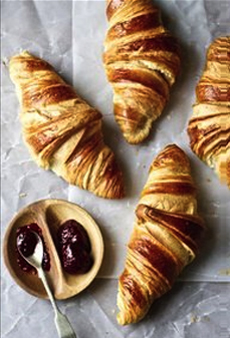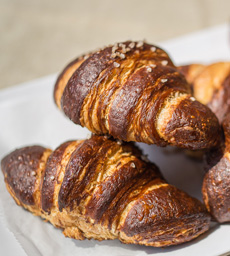Bread Glossary: A Glossary Of The Different Bread TypesPage 3: Bread Glossary C This is Page 3 of an 9-page article. Click on the red links below to visit other pages. This glossary is protected by copyright and cannot be reproduced in whole or part. You are welcome to link to it.
|
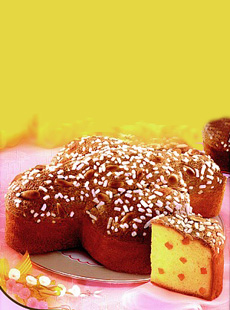 Colomba di Pasqua, a dove-shaped Easter bread. Photo courtesy Bauli.it. |
|
| CALZONE Calzone, the Italian word for “stocking,” is a turnover made from pizza dough, stuffed with mozzarella and ricotta cheeses (different cheeses and other ingredients such as meat and vegetables can be added), and deep-fried. In the U.S., it is often served with a marinara sauce for dipping.
|
||
| CHALLAH Challah is a braided, sweetened egg bread that is part of the celebration of the Jewish Sabbath. The word refers to a tithe of bread that was given to the priests, who had no income; a portion of the dough was sanctified and tithed, the remainder was given over for ordinary consumption. Jewish custom requires that Sabbath and holiday meals begin with challah. Here’s the challah recipe for the bread in the photo at right.
|
 This challah is made “Sephardic style” in swirled loaf rather than the traditional long braided style (photo courtesy National Honey Board). Below: chapata, a staple Indian flatbread (photo courtesy VegKitchen.com). |
|
| CHAPATI A type of roti, chapati is a staple flatbread of North and Western India. It is made from whole-grain durum wheat (atta flour), water and salt, rolled into discs of approximately five inches in diameter, cooked on a hot grill and served with ghee (clarified butter). It is generally eaten with lentil soup and curry dishes. In the U.S. and elsewhere, they are also used for fast food wrap sandwiches, not dissimilar to the tortilla becoming a burrito wrap.
|
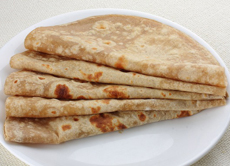 |
|
| CIABATTA Pronounced cha-BOT-a, ah Italian wheat loaf with a porous crumb, made with yeast. It is baked in a variety of styles, depending on the region—the crispness of the crust and the density of the crumb will vary. Some are seasoned with marjoram or rosemary, some made with olive oil or milk. The unusual elongated, flat shape gives it its name—ciabatta means carpet slipper—and it can be recognized by the dusting of flour on the top. It is a popular sandwich bread, used for panini. Some artisan bakers make the “carpet slipper” in a ring form.
COB |
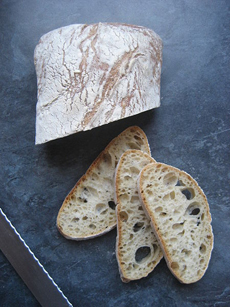 Ciabatta. Photo by Vincent Talleu | Wikimedia. |
|
| COBURG A cob or boule with a large cross slashed across the top. |
||
| COLOMBA DI PASQUA An Italian Easter bread, made in the shape of a dove. The classic colomba is a soft yeast dough with candied fruit (including orange peel), topped with icing, whole almonds, and granulated sugar (see photo at the top of the page). Colomba di Verona, shown in the photo, is a variation without candied fruit. |
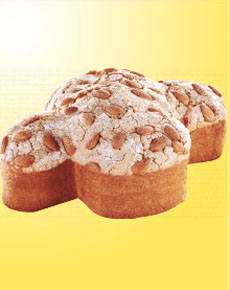 Colomba di Verona, a dove-shaped Easter bread. Photo courtesy Bauli.it. |
|
| CORNBREAD Corn, a grain indigenous to America, is milled into cornmeal, which can be baked into bread. There are several types of cornbread. The earliest is a skillet bread (also known as hoecake), made from cornmeal, egg and buttermilk and fried in a fat, then baked in the oven. The result is a cake-like bread with a large, dense crumb and a crunchy crust. This bread will tend to be dense, meant more as an accompaniment than as a bread meant to stand on its own. Corn pone is a cornbread made of a thick cornmeal dough that is baked or fried. Johnnycakes are batter-based, skillet-fried cornbread similar to pancakes. Cornmeal is also used to make standard bread loaves.
CORN PONE |
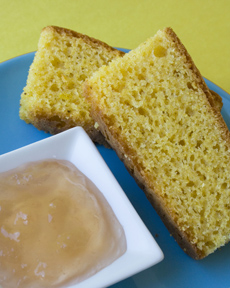 Cornbread with corn jelly. Photo by Claire Freierman | THE NIBBLE. |
|
| COTTAGE BREAD A large, round bread with a smaller round placed on top. It looks less like a cottage than a chignon hairdo.
|
||
| COTTAGE BREAD A rustic style of bread. See peasant bread.
|
||
| CRACKER A small, crisp bread-like product. The cracker is an American invention; the first cracker-like product was made in 1792 by John Pearson of Newburyport, Massachusetts, who mixed flour and water into “pilot bread.” The long shelf life was popular with sailors, who called it hardtack and sea biscuits. The name “cracker” evolved from the crackling noise when another Massachusetts baker, Josiah Bent, burned a batch of biscuits in his oven in 1801. Years later, he sold his business to the company that became Nabisco. Crackers are made of flour, water and salt; some have other seasonings, but unlike bread, there is no leavening. There are many styles, which include cheese crackers, oyster crackers for soup, saltines and matzoh-like water biscuits. See reviews of our favorite gourmet crackers.
|
 Why serve soup and crackers with ordinary crackers? See these and other gourmet crackers. Photo by Melody Lan | THE NIBBLE. |
|
| CRISPBREAD Crispbread was invented in Scandinavia in medieval times, baked in Sweden and Finland to preserve the wheat crop over the long, cold winters. Originally from rye flour, salt and water, today there are varieties made from all the major grains. Some are available in large, decorative rounds, good for parties; most are available in cracker-size portions. Crispbreads are also called flatbreads, but this confuses the term with the many soft flatbreads (pita, tortillas, etc.); so crispbread is the preferred term. Read our review of Wasa crispbread and crispbread recipes. |
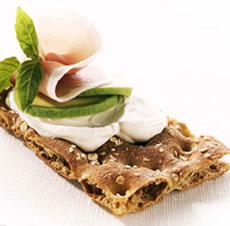 Versatile crispbread can be the base for an easy hors d’oeuvre. See Wasa crispbread recipes. |
|
| CROISSANT A rich, buttery, crescent-shaped roll made of puff pastry that layers yeast dough with butter (known as laminating). Stories of the roll being made in the shape of the crescent of the Turkish flag, after the defeat of the Turks in the Siege of Vienna in 1683, are a perpetuated myth. Recipes for croissants do not appear in recipe books until the early 1900s, according to the Oxford Companion To Food, and the earliest French reference is in 1853. The croissant is descendant of the Austrian kipfel, a crescent roll that was brought to Paris in 1938 or 1939 by August Zang, an Austrian military officer. The kipfel was ultimately interpreted into puff pastry by the French, where it achieved immortality as the croissant. You can read this history in Jim Chevallier’s book, August Zang and the French Croissant: How Viennoisserie Came To France (Kindle edition). Traditionally a breakfast bread served with jam and butter, two variations include the almond croissant, filled with frangipane and topped with sliced almonds, and the “chocolate croissant,” correctly called pain au chocolat, baked with a piece of dark chocolate in the center. In the early 1970s, croissants became sandwich substitutes as they evolved from their two traditional fillings, chocolate and almond paste, into many savory variations, from broccoli to ham and cheese, as well as additional sweet varieties. Bavarian Croissant or Pretzel Croissant: A croissant made of pretzel-likedough—a combination of bread flour and whole wheat flour. It is not puff pastry, but a soft pretzel-type dough in a triangle wrap, like a croissant. |
|
|
| CROSTINI Crostini are small toasts or large croutons—thin slices of lightly-toasted bread, that are used for spreads like paté, as a base for canapé toppings, or as a bread with soups and salads. They can be made from round baguette slices, sliced from rectangular loaves, sliced into diagonals, etc. In Europe, slices of garlic bread would be referred to as crostini.
|
||
| CROUTON Crouton has two meanings. The first is a small cube (no more than half an inch) of rebaked bread, often seasoned, that is added to salads, soups and other dishes for flavor and texture. The word derives from the French croûte, crust. The second is a small slice of toasted bread, such as baguette, used as a base for canapés, for spreads and dips, and as a bread accompaniment to soups and salads. |
 Croutons. Photo by Koos Swans | SXC. |
|
| CRUMB The crumb is the technical term for the interior, soft part of the bread that comprises the interior texture, gluten network, tenderness and general feel. The crumb texture and size varies based on each style of bread. Kneaded breads generally have fine, even crumbs (although sourdough starters may create large bubbles); batter breads have a more coarse crumb. “Crumb” is a different reference from “crumbs,” small pieces of the crumb or crust that break off from the loaf, slice or roll.
|
||
| CRUST The outer, hard portion of bread. The inside is called the crumb. |
||
| CUBAN BREAD Cuban bread, used to make an authentic Cuban sandwich, is a white bread similar to French and Italian baguette-like loaves, but made with lard or vegetable shortening; it is usually made in long, baguette-like loaves. Continue To Page 4: Terms From D To F |
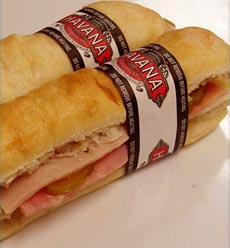 Cuban sandwich. Photo courtesy Havana Roadhouse. |
|
Last Updated Apr 2018
© Copyright 2005-2025 Lifestyle Direct, Inc. All rights reserved. All images are copyrighted to their respective owners.
